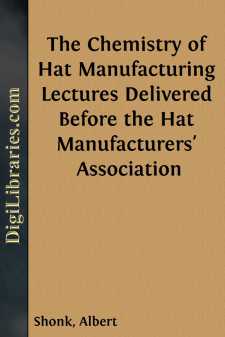Categories
- Antiques & Collectibles 13
- Architecture 36
- Art 48
- Bibles 22
- Biography & Autobiography 813
- Body, Mind & Spirit 142
- Business & Economics 28
- Children's Books 14
- Children's Fiction 11
- Computers 4
- Cooking 94
- Crafts & Hobbies 4
- Drama 346
- Education 46
- Family & Relationships 57
- Fiction 11828
- Games 19
- Gardening 17
- Health & Fitness 34
- History 1377
- House & Home 1
- Humor 147
- Juvenile Fiction 1873
- Juvenile Nonfiction 202
- Language Arts & Disciplines 88
- Law 16
- Literary Collections 686
- Literary Criticism 179
- Mathematics 13
- Medical 41
- Music 40
- Nature 179
- Non-Classifiable 1768
- Performing Arts 7
- Periodicals 1453
- Philosophy 64
- Photography 2
- Poetry 896
- Political Science 203
- Psychology 42
- Reference 154
- Religion 513
- Science 126
- Self-Help 84
- Social Science 81
- Sports & Recreation 34
- Study Aids 3
- Technology & Engineering 59
- Transportation 23
- Travel 463
- True Crime 29
The Chemistry of Hat Manufacturing Lectures Delivered Before the Hat Manufacturers' Association
by: Albert Shonk
Categories:
Description:
Excerpt
LECTURE I
TEXTILE FIBRES, PRINCIPALLY WOOL, FUR, AND HAIR
Vegetable Fibres.—Textile fibres may be broadly distinguished as vegetable and animal fibres. It is absolutely necessary, in order to obtain a useful knowledge of the peculiarities and properties of animal fibres generally, or even specially, that we should be, at least to some extent, familiar with those of the vegetable fibres. I shall therefore have, in the first place, something to tell you of certain principal vegetable fibres before we commence the more special study of the animal fibres most interesting to you as hat manufacturers, namely, wool, fur, and hair. What cotton is as a vegetable product I shall not in detail describe, but I will refer you to the interesting and complete work of Dr. Bowman, On the Structure of the Cotton Fibre. Suffice it to say that in certain plants and trees the seeds or fruit are surrounded, in the pods in which they develop, with a downy substance, and that the cotton shrub belongs to this class of plants. A fibre picked out from the mass of the downy substance referred to, and examined under the microscope, is found to be a spirally twisted band; or better,
Fig. 1.an irregular, more or less flattened and twisted tube (see Fig. 1). We know it is a tube, because on taking a thin, narrow slice across a fibre and examining the slice under the microscope, we can see the hole or perforation up the centre, forming the axis of the tube (see Fig. 2).
Fig. 2.Mr. H. de Mosenthal, in an extremely interesting and valuable paper (see J.S.C.I., 1904, vol. xxiii. p. 292), has recently shown that the cuticle of the cotton fibre is extremely porous, having, in addition to pores, what appear to be minute stomata, the latter being frequently arranged in oblique rows, as if they led into oblique lateral channels. A cotton fibre varies from 2·5 to 6 centimetres in length, and in breadth from 0·017 to 0·05 millimetre. The characteristics mentioned make it very easy to distinguish cotton from other vegetable or animal fibres. For example, another vegetable fibre is flax, or linen, and this has a very different appearance under the microscope (see Fig. 3). It
Fig. 3.has a bamboo-like, or jointed appearance; its tubes are not flattened, nor are they twisted. Flax belongs to a class called the bast fibres, a name given to certain fibres obtained from the inner bark of different plants. Jute also is a bast fibre. The finer qualities of it look like flax, but, as we shall see, it is not chemically identical with cotton, as linen or flax is. Another vegetable fibre, termed "cotton-silk," from its beautiful, lustrous, silky appearance, has excited some attention, because it grows freely in the German colony called the Camaroons, and also on the Gold Coast. This fibre, under the microscope, differs entirely in appearance from both cotton and flax fibres. Its fibres resemble straight and thin, smooth, transparent, almost glassy tubes, with large axial bores; in fact, if wetted in water you can see the water and air bubbles in the tubes under the microscope. A more detailed account of "cotton-silk" appears in a paper read by me before the Society of Chemical Industry in 1886 (see J.S.C.I., 1886, vol. v. p. 642). Now the substance of the cotton, linen or flax, as well as that of the cotton-silk fibres, is termed, chemically, cellulose. Raw cotton consists of cellulose with about 5 per cent. of impurities. This cellulose is a chemical compound of carbon, hydrogen, and oxygen, and, according to the relative proportions of these constituents, it has had the chemical formula CHO assigned to it. Each letter stands for an atom of each constituent named, and the numerals tell us the number of the constituent atoms in the whole compound atom of cellulose. This cellulose is closely allied in composition to starch, dextrin, and a form of sugar called glucose. It is possible to convert cotton rags into this form of sugar—glucose—by treating first with strong vitriol or sulphuric acid, and then boiling with dilute acid for a long time. Before we leave these vegetable or cellulose fibres, I will give you a means of testing them, so as to enable you to distinguish them broadly from the animal fibres, amongst which are silk, wool, fur, and hair....


